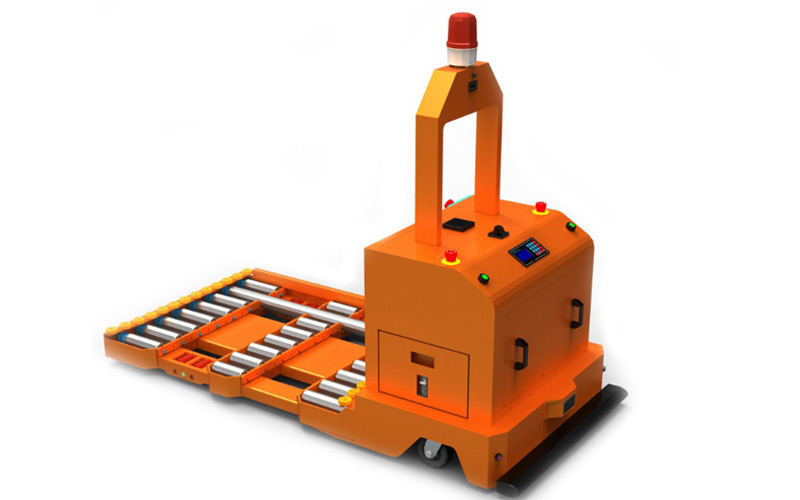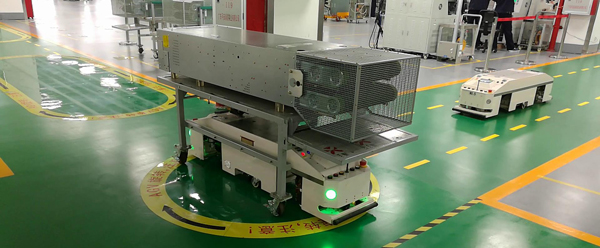Using Wireless Battery-free AGVs in Manufacturing
Automated Guided Vehicles (AGVs) are not just for delivery and logistics applications. They’re playing an increasing role as main assembly line conveyances. A key enabling technology permitting AGVs to perform in the heavy duty world of production line manufacturing is Inductive Power Transfer (IPT®), also known as wireless power. This enables AGVs to abandon the battery and operate continuously without need for recharging or risk of down time due to dead batteries.
AGVs have long been used for delivery and material handling in logistics and warehouse applications, where the classic battery powered AGV is ideally suited to operate. An overnight charge is usually sufficient to permit operations through the entire work day, and there frequently are enough stopping points (and times) to permit opportunity charging. However the higher duty cycle demands in production and continuous assembly line operations do not easily permit opportunity charging. Battery operated AGVs have often failed to perform especially in 2 and 3 shift operations. The main limiting factor is the energy storage capability of the AGV battery.

Eliminate the battery
Sure, the AGVs could have bigger batteries, but that adds cost and weight to each AGV, and they still need to be charged. That requires available ‘dead time’ for the AGVs to be parked for charging. Another solution is to add additional AGVs to the system and always have some offline in a charging station, but that is an extra cost too. Assembly line AGVs tend to be larger and more expensive than delivery AGVs, with additional features such as tooling plates, lifts and fixtures. Getting battery operated AGVs to operate through a two shift production cycle can be a challenge. Getting them to operate continuously through 3 shifts is not practical. However, by eliminating the battery, the AGV is freed from its energy constraint. Wireless power supply permits the AGVs to operate continuously, without ever needing to stop for a charge, just as if they were ‘plugged in’, but without the plug.
Wireless data communication for machine control has proven to be robust and stabile in even the most demanding manufacturing environments, including automotive. Wireless data is not only being used for monitoring and data acquisition, but also for machine control and safety monitoring, with multiple devices that are rated to transmit safety signals via wireless and meet safety and security standards. However, wireless power supply enables the ‘cord’ to be cut completely so the AGV can operate automatically and indefinitely.
Energy and Power
Electric Power is the rate of Energy consumption per unit time (E=P*t). Power consumption of 1 kilowatt for one hour is equivalent to 1 kilowatt-hour (kWh) of Energy consumption. The main challenge for AGV batteries is typically Energy, not Power. Is there enough energy in the batteries to keep the AGV running all day, rather than is the battery powerful enough to handle the heaviest load? When the batteries are eliminated from the AGV, and it is powered wirelessly from the floor, then the primary focus becomes Power. For example, what is the peak power required to accelerate my fully loaded AGV, and is my inductive power pickup sized appropriately? For the battery operated AGV the focus is to provide the AGV with sufficient Energy to sustain the average power consumption over the required number of operating hours. When designing battery-free AGVs, the focus is on providing the AGV with sufficient peak power capability to handle the heaviest load at the highest speed.
Therefore, when sizing wireless power systems, a lot of attention is paid to the electrical power requirements, not only of each AGV, but of the system as a whole. There is a big difference between an asynchronous stop-start (workstation) assembly line, a continuously moving assembly line, and a synchronous indexing assembly line. Synchronous indexing usually has the highest peak power requirement since all the AGVs accelerate simultaneously, while asynchronous stop-start usually has the lowest system power requirement since only a few AGVs are ever moving.
So, when sizing an IPT® system, the peak and average power requirements of the individual AGVs need to be considered, and also the peak and average power requirements of the combined system whereby the duty cycle and simultaneous factor of the AGVs is taken into account.

Inductive Power Transfer (IPT®)
Inductive Power Transfer (IPT®) technology has been commercially available since the 1990’s. It is capable of transferring power in the kW range. The basic principle is the same form of electromagnetic induction used by conventional transformers. However, in this case instead of tightly wound (and closely coupled) coils on a shared magnetic core, the primary and secondary windings are separate and may move with respect to one another. Nonetheless, an alternating current in the primary conductor induces an alternating current in the secondary with which it is (albeit loosely) coupled by magnetic field. In order to make this process practical, the operating frequency is increased to 20 kHz. This reduces the size of the components since the energy density is increased in proportion to the frequency, in the same way that aircraft use 400 Hz frequency in order to reduce the size (and weight) of their electrical equipment. In addition, IPT uses tuned resonant coils in order to improve the coupling.
Contrary to popular hearsay, loosely coupled inductive power systems are more efficient that battery-powered systems. The efficiency of the inductive coupling between primary and secondary in an IPT® system is in the order of 96%. This is much better than batteries, which are typically only able to return 80% of the charging energy applied.
- Pre:Why do we need a YMP Wireless Charger 2020/3/3
- Next:The Benefits Of Wireless Charging 2020/2/28
